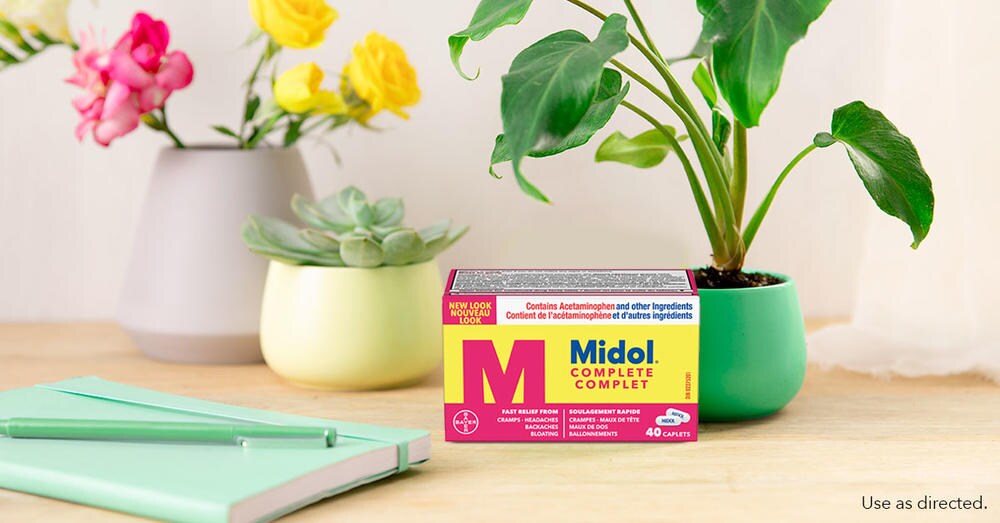Adapted from content prepared by Pandia Healthcare, a Bayer Partner
The period pain that often happens with an individual’s menstrual cycle can be debilitating, so much so that it may begin to stop you from your daily tasks. Thankfully, it doesn’t have to be this way forever. There are many methods and products that you can use to relieve period cramps.
What Are Menstrual Cramps?
Menstrual cramps are pains that typically occur in the lower abdomen around the time of their period. For most uteri-bearing people, the pain begins one to three days before the start of an individual’s period, peaks 24 hours after bleeding starts, and stops two to three days after bleeding stops. The pain is usually mild, but for some, the pain can be so severe that it interferes with normal activities for several days in a month. Menstrual cramps are highly prevalent and are commonly untreated.
Cramps occur as a result of prostaglandins, hormone-like substances that cause muscle contractions in the uterus, eventually resulting in a shedding of the lining. When prostaglandin levels increase, cramps may be more severe. Doctors call this dysmenorrhea, which can be either primary or secondary dysmenorrhea. Primary dysmenorrhea is a pain in the uterus that happens before or during your period. Secondary dysmenorrhea is typically caused by a disorder in the reproductive system, and it involves severe pain that lasts a longer stretch of time. If you are experiencing severe menstrual pain, unusual pain or pain outside of your menstrual cycle, please see your doctor.

Ways to Relieve Menstrual Cramps
Over-the-Counter Medications
Non-steroidal anti-inflammatory drugs (NSAIDs) can help relieve period pain. NSAIDs are effective pain relievers but like all drugs, they may not be right for everyone. Other pain relievers such as acetaminophen can also be used. Please always read and follow directions on the label before taking any medication and speak to your doctor if you have any questions.
Heat Therapy
An at-home remedy for easing cramps is the application of heat via a patch, wrap, electric heating pad, hot water bottle or having a soak in a warm bath. This can relax the tensed muscle wall of your uterus and boost circulation. Additionally, the soothing effect of heat can be beneficial for curbing other period symptoms such as body aches. Heat patches and electric heating pads can be found at pharmacies and other retailers.
Exercise
Regular exercise can help reduce or even prevent menstrual pain. Regular exercise releases serotonin and endorphins that act as “happy” hormones. These hormones can help off-set menstrual cramping, pain, and mood disturbance. Serotonin and endorphins released during regular exercise can lessen period pain.
What's the Takeaway
Menstrual pain is no joke! Thankfully, experiencing unpleasant symptoms during your period does not have to be. Don’t just grin and bear it. Treat your period pain! You deserve to feel empowered to take charge of your body.
Disclaimer: The above information is for general informational purposes only and is NOT a substitute for professional medical advice. Always seek the advice of your doctor/primary care provider before starting or changing treatment.
How can Midol® help?
Midol® has a selection of products, including Maxidol® Liquid Gels for fast period pain relief. Midol® Complete and Midol® PMS are also options that can be used to relieve cramps in addition to other period-related symptoms like bloating and swelling. Midol® can be purchased over-the-counter from pharmacies, grocery stores and other retailers throughout Canada.
While Midol® can be highly effective on its own for period pain relief, additional self-care techniques may help you feel even better. Incorporating exercise, a nutritious diet, hydration, and plenty of rest into your daily routine can be extremely beneficial. You can even try mindfulness activities such as meditation and yoga to relieve stress associated with your period.
Sources:
The American College of Obstetricians and Gynecologists (ACOG). (2022). Dysmenorrhea: Painful Periods. Retrieved June 2022, from https://www.acog.org/womens-health/faqs/dysmenorrhea-painful-periods
The Society of Obstetricians and Gynaecologists of Canada (SOGC). (2017). No. 345-Primary Dysmenorrhea Consensus Guideline. J Obstet Gynaecol Can. 39(7):585-595.
|
Disclaimer: The above information is for general informational purposes only and is NOT a substitute for professional medical advice. Always seek the advice of your health care professional before starting or changing treatment. |
